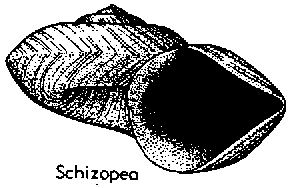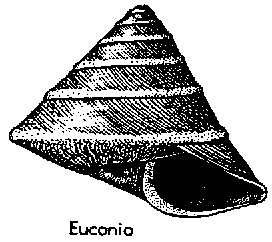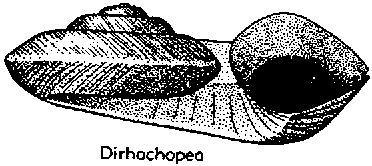
Schizopea typica
diameter about 4 cm
Late Dolgellian to Early Tremadoc of Laurentia
(Tremadoc of Missouri)
image © xxxx Knight, et al., 1960 p.I200
| Gastropoda | ||
| Mollusca | Gastropoda |
Conchifera
└─► |
|||
◄═╤═Eogastropoda (paraphyletic or polyphyletic)
└─Orthogastropoda |
|
Abbreviated Dendrogram
Mollusca
├─Aculifera
└─Conchifera
╘═Helcionelloida
└─┬─Bellerophontoidea
└─Gastropoda (crown group)
╞═Eogastropoda (paraphyletic or polyphyletic)
│ ├?─Macluritoidea
│ ├?─Euomphaloidea
│ └─Patellogastropoda
└─Orthogastropoda
├─Vetigastropoda
├─Neritimorpha
└─┬─Caenogastropoda
└─Heterobranchia
├─Opisthobranchia
└─Pulmonata
|
Contents
Index |
The Latest Cambrian (Late Dolgellian Age) and Earliest Ordovician (Early Tremadoc saw a tremendous radiation of early gastropods. During this period the gastropods, like the cephalopods, underwent a tremendous evolutionary radiation. From one or two planispiral types, represented by a Tropidodiscid ancestor, there developed several distinct taxa, including high spired, lower spired, planispiral, and hyperstrophic types. These could be grouped in three main clades: Eogastropoda, Orthogastropoda, and the extinct Bellerophontoidea. By the earliest Ordovician the three main clades of gastropods had already established themselves and were continuing to diversify into a range of different morphotypes and lifestyles.
The "Pleurotomariacea" or slit shells and their relatives have traditionally [Knight, et al., 1960] been considered among the earliest and most primitive of the gastropods, first appearing in the Furongian.
Dr Peter Wagner however [Wagner 1999] has used cladistic methodology to try to determine the phylogeny of early Palaeozoic gastropods, and his findings indicate that the Early Paleozoic Pleurotomarioids are actually a polyphyletic assemblage. A diverse assemblage of forms that have traditionally been placed in the "Pleurotomariacea" actually belong among the Euomphalida and the Murchisoniida.
Gastropoda: = Crown Group Definition of Gastropoda, here defined as the LCA (Latest Common Ancestor) of all extant gastropods)
Stratigraphic Range: Latest Cambrian [Late Dolgellian] to Recent
Unnamed Node : Strepsodiscus + Tropidodiscidae + : Schizopea + Euconiidae + Eogastropoda + Unnamed Node
Characteristics: $ larval operculum; $ cephalic and epipodial tentacles; $ post-torsional right gonad only; $ radular cartilages not hollow; $ oesophagus showing torsion; $ hypoathroid nervous system (adjacent pleural and pedal ganglia) [all from Haszprunar 1988 p.9]; Anisotrophic (helically coiled) shell; body asymmetry. Some of these characters may also pertain to "Gastropodiformes" in general.
Links: see Links section
 |
Schizopea typica image © xxxx Knight, et al., 1960 p.I200 |
Schizopea: Schizopea typica (= Ophiletinae in part (paraphyletic))
Stratigraphic Range: Furongian (Late Dolgellian Age) to Early Ordovician (Early Tremadoc
Geographic Distribution: Laurentia [= N. Am - Knight, et al., 1960 p. I200]
Gastropoda : Schizopea + Euconiidae + Eogastropoda + Unnamed Node
Characteristics: spire low, widely phaneromphalus, sutures deep, sinus culminating at blunt anggulation that forms the periphery [Knight, et al., 1960 p. I200]
Notes: Knight, et al., 1960 includes this genus under the subfamily Ophiletinae of the family Raphistomatidae and superfamily Pleurotomariacea. But cladistic analysis by Wagner 1999 indicates that the species Schizopea typica is actually a member of an unresolved tetrachotomy that includes the most basal helically-coiled gastropods. It may be that related species may also belong in this clade
 |
Euconia etna image © xxxx Knight, et al., 1960 p.I200 |
"Euconiidae": Euconia etna, Jarlopsis conicus, Rhombella umbilicata (= Ophiletinae in part (paraphyletic))
Stratigraphic Range: Early Ordovician (Early Tremadoc to Floian)
Geographic Distribution: Laurentia [= N. Am - Knight, et al., 1960 p. I200]
Gastropoda : Schizopea + "Euconiidae" + Eogastropoda + Unnamed Node
Characteristics: conical trochiform shell, sutures shallow, sinus culminating at angular periphery just above upper suture [Knight, et al., 1960 p. I 200]
Notes: Knight, et al., 1960 includes Euconia under the subfamily Ophiletinae of the family Raphistomatidae and superfamily Pleurotomariacea. But cladistic analysis by Wagner 1999 places this genus as part of off-shoots an unresolved tetrachotomy that includes the most basal helically-coiled gastropods. I have informally coined the family name "Euconiidae" to distinguish this clade from other early gastropods
 |
Dirhachopea normalis image © xxxx Knight, et al., 1960 p.I200 |
unnamed node: (= Ophiletinae in part (paraphyletic))
Stratigraphic Range: Furongian (Late Dolgellian Age) to Early Ordovician (Late Tremadoc
Gastropoda : Schizopea + Euconiidae + Eogastropoda + Unnamed Node : Dirhachopea normalis + Gasconadia putilla + (Dirhachopea subrotunda + "Sinuopeidae")
Notes: node 4 on diagram based on Wagner 1999
 |
Sinuopea sweeti image © McGraw Hill Book Company, from Moore, et al. 1952, p.291 |
"Sinuopeidae": Sinuopea basiplanata, Taenospira emminencis, Sinuopea sweeti, Taeniospira st. clairi (= Sinuopeinae and Eotomariinae in part (paraphyletic))
Stratigraphic Range: Furongian (Late Dolgellian Age) to Early Ordovician (Late Tremadoc
Geographic Distribution: Laurentia [= N. Am - Knight, et al., 1960 p. I198, 203]
Unnamed Node : Dirhachopea subrotunda + Sinuopeidae : Bellerophontoidea + Orthogastropoda
Characteristics: Turbinoform, sinus wide, with or without slit
Notes: This is a paraphyletic grouping. Knight, et al., 1960 includes Sinuopea in the subfamily Sinuopeinae (Furongian to Late Silurian) of the family Sinuopeidae (Furongian to Middle Permian) in the superfamily Pleurotomariacea, and Taenospira as the earliest member of the tribe Ptychomphalides (Furongian to Early Jurassic) of the subfamily Eotomariinae of the family Eotomariidae (also Furongian to Early Jurassic). But cladistic analysis by Wagner 1999 indicates that these forms are basal members of the clade that includes both the Murchisoniida and the Bellerophontoidea. It may be that some other members of the Sinuopeinae and Eotomariinae may also belong here, extending the stratigraphic range of this assemblage
 |
Early gastropod relationships image © Peter Wagner |
The diagram (click the thumbnail for larger image) shows the suggested relationships among late Dolgellian and Early Tremadocian (latest Cambrian and earliest Ordovician) gastropods, according to cladistic analysis [Wagner 1999], which is the one adopted here. The colors in the diagram refer to taxonomic assignments based on Knight, et al., 1960, the rather dated Treatise of Invertebrate Paleontology. Taxa previously considered Pleurotomariacea (green) are actually more closely related to the Euomphaloidea (red) or Murchisoniida (blue). Even the torted Bellerophontiforms (orange) are here shown to diphyletic (Streptodiscus. For the sake of convenience the Order Bellerophontoidea is here defined as a monophyletic crade that begins at node 10.
page uploaded 6 March 2003
checked ATW050825